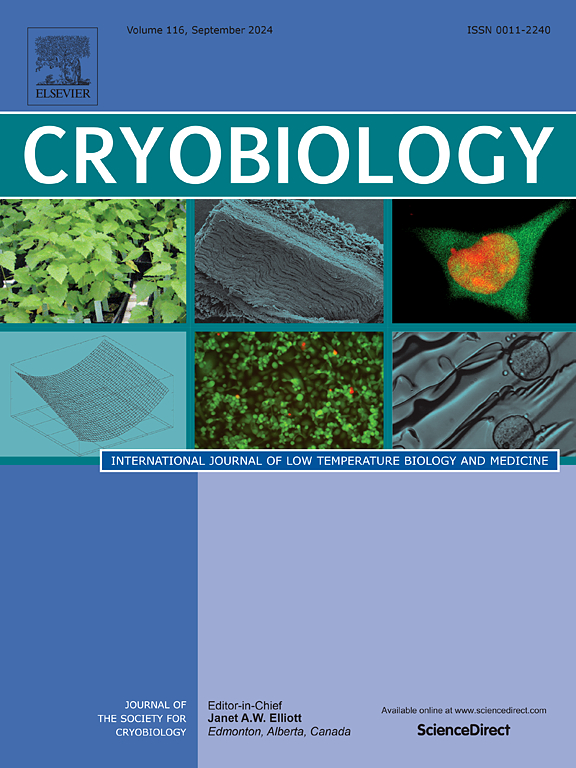Genome-wide discovery of underlying genetic factors associated with fresh and frozen-thawed semen traits in composite ram breeds exhibiting different cryotolerance
IF 2.1
3区 生物学
Q2 BIOLOGY
引用次数: 0
Abstract
Fewer studies investigate the effects of underlying genetic factors related to semen characteristics, significantly affecting sheep farm profitability. This study aimed to identify single nucleotide polymorphisms (SNP) and genomic regions associated with fresh and frozen-thawed semen traits in rams with low (Hasak) and high (Hasmer) cryotolerance. Semen collected from 11 (5 Hasak with low and 6 Hasmer with high cryotolerance) rams cryopreserved in 0.25 ml straws in the breeding season. Quality characteristics were determined in fresh, equilibrated, and frozen-thawed semen. A Genome-Wide Association Study (GWAS) was conducted to unveil the genetic structure that might be attributed to cryotolerance in low and high cryotoleranced rams. Fresh (regarding total and progressive motility) and equilibrated semen quality were similar in Hasak and Hasmer rams (p > 0.6). However, the freeze-thawing process had a more pronounced negative effect on ram semen traits in Hasak than in Hasmer (p < 0.05). GWAS revealed 27 SNPs correlated with post-thaw semen parameters. Moreover, network analyses revealed pathways related to sperm ion channels and their activities, providing insights into the intricate molecular mechanisms underlying sperm physiology and emphasizing their role in potentially impacting sperm cryotolerance. The functional significance of detected SNPs and the associated pathways require further exploration.
在具有不同低温耐受性的复合公羊品种中,发现与新鲜和冻融精液性状相关的全基因组遗传因素。
很少有研究调查与精液特征相关的潜在遗传因素的影响,这些因素会显著影响羊场的盈利能力。本研究旨在鉴定低(Hasak)和高(Hasmer)低温耐受性公羊新鲜和冻融精液性状相关的单核苷酸多态性(SNP)和基因组区域。在繁殖季节采集11只公羊(5只低低温耐受性的哈萨克公羊和6只高低温耐受性的哈萨克公羊)的精液,用0.25 ml的吸管冷冻保存。测定了新鲜、平衡和冻融精液的质量特征。通过全基因组关联研究(GWAS)揭示了低低温耐受性和高低温耐受性公羊的低温耐受性遗传结构。Hasak公羊和Hasmer公羊的新鲜(总活力和渐进活力)和平衡精液质量相似(p < 0.6)。冻融过程对哈萨克公羊精液性状的负面影响显著高于哈默公羊(p < 0.05)。GWAS发现27个snp与解冻后精液参数相关。此外,网络分析揭示了与精子离子通道及其活动相关的途径,为精子生理学背后复杂的分子机制提供了见解,并强调了它们在潜在影响精子低温耐受性中的作用。检测到的snp及其相关途径的功能意义有待进一步探索。
本文章由计算机程序翻译,如有差异,请以英文原文为准。
求助全文
约1分钟内获得全文
求助全文
来源期刊

Cryobiology
生物-生理学
CiteScore
5.40
自引率
7.40%
发文量
71
审稿时长
56 days
期刊介绍:
Cryobiology: International Journal of Low Temperature Biology and Medicine publishes research articles on all aspects of low temperature biology and medicine.
Research Areas include:
• Cryoprotective additives and their pharmacological actions
• Cryosurgery
• Freeze-drying
• Freezing
• Frost hardiness in plants
• Hibernation
• Hypothermia
• Medical applications of reduced temperature
• Perfusion of organs
• All pertinent methodologies
Cryobiology is the official journal of the Society for Cryobiology.
 求助内容:
求助内容: 应助结果提醒方式:
应助结果提醒方式:


